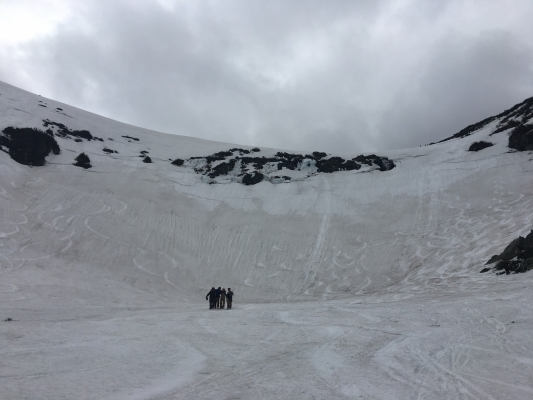As winter turns rapidly to spring, a number of hazards become prevalent in the steep terrain of the Presidential Range and particularly the Headwall of Tuckerman Ravine. Waterfall holes, glide cracks or crevasses, moats around cliffs and rocks, and other deep holes open as the thick snowpack melts. A fall into these holes, which often also have significant amounts of cold flowing water which can quickly cause hypothermia, can be very difficult to escape or be rescued from. Such accidents have resulted in several fatalities in Tuckerman Ravine. A lucky skier had a very close call in this type of accident yesterday.
At 1:58 PM on Monday, April 22, a skier fell over the Tuckerman Ravine headwall and into one of several waterfall holes. Partners and bystanders quickly initiated rescue efforts and also called 911 for emergency response. Unsure of where under the snow the fallen skier was, a beacon search was initiated and could have been helpful, though this was a non-avalanche accident. At 2:18 pm, after 20 minutes out of view to the rescuers, the subject climbed out of a different hole in the snow and slid down to the rescue party below him in the slope. He had lost his skis, poles, and pack.
The subject was alert, oriented, and able to walk but in pain from several impacts during the fall. He was also cold and wet from spending most of the 20 minutes in very cold flowing water, though not submerged. The rescue party quickly changed his clothes to drier ones. They wrapped him in a sleeping bag and briefly transported him in a rescue litter obtained from the nearby Connection Cache of emergency supplies. In effort to warm the subject, the rescue party then helped the subject begin walking down the Tuckerman Ravine Trail towards Hermit Lake.

The fall line glissade track just right of center leads up to waterfall hole and accident site, with partners of the subject shown helping him walk downhill.
Meanwhile, U.S. Forest Service Snow Rangers were notified of the incident by emergency dispatchers. They travelled to Hermit Lake with urgency, aware than similar accidents have historically been fatal. Upon arriving at Hermit Lake, Snow Rangers were told by the AMC caretaker that the subject had extracted himself from the waterfall hole and was walking, with aid, down to Hermit Lake. They proceeded up the trail, meeting the rescue party at 3:20 PM. The subject, still alert and oriented but now warmer, was transported to Pinkham Notch via snowcat and released to the care of friends.
This positive outcome should be regarded as quite lucky and be taken as a warning for all who travel on steep snow slopes in spring conditions in our mountains. Had the subject, who was a strong athlete and also a climber, been unable to self-extricate himself from the waterfall hole the outcome could have been far worse. Many of these deep holes in the snow are impossible for even the strongest individual to climb out of. Extricating a person from these holes can be very dangerous for rescuers and is difficult to accomplish in a sufficiently timely manner to save a life. We know the subject would urge you to learn from this accident, giving potentially deep holes and glide cracks in the snow a wide berth and taking care to not fall above one.
The rescue initiated by partners and bystanders of the subject was a positive example we would also like you to learn from. Partners were paying attention to each other and able to quickly initiate a rescue. They had sufficient dry clothing and emergency supplies to provide proper care for the subject. Several emergency medical professionals observed the accident and immediately helped rescue efforts. Rescuers had knowledge that a litter and hypothermia wrap materials were available in nearby Connection Cache and used them. All individuals on the scene had avalanche rescue gear, as large wet slab avalanches were forecast as unlikely but not impossible that day. While a call was made for professional rescue, this group realized that they could provide timely aid to the subject and took appropriate action that could have resulted in an effective evacuation had professional rescue been delayed or unavailable. This self-reliant level of accident response is commendable. It is also the level of response that everyone travelling in the backcountry should be prepared for, every time you’re out.
Please learn from this accident to have a safer spring ski season, and see you on the hill!
